Finland
From Wikipedia, the free encyclopedia
This article is about the country in Northern Europe. For other uses, see Finland (disambiguation).
| Republic of Finland Suomen tasavalta (Finnish) Republiken Finland (Swedish) | ||||||
|---|---|---|---|---|---|---|
| ||||||
| Anthem: Maamme (Finnish) Vårt land (Swedish) "Our Land" | ||||||
Location of Finland (dark green) | ||||||
| Capital (and largest city) | Helsinki 60°10′N 024°56′E | |||||
| Official language(s) | Finnish Swedish | |||||
| Recognised regional languages | Saami | |||||
| Ethnic groups (2006) | Finn 93.4% Swede 5.6% Russian 0.5% Estonian 0.3% Roma (Gypsy) 0.1% Sami 0.1% | |||||
| Demonym | Finns, Finnish | |||||
| Government | Parliamentary republic[1] | |||||
| - | President | Tarja Halonen (till March 1st, 2012) (SDP) President-elect: Sauli Niinistö (NCP) | ||||
| - | Prime Minister | Jyrki Katainen (NCP) | ||||
| - | Speaker of the Parliament | Eero Heinäluoma (SDP) | ||||
| Independence | ||||||
| - | Autonomy within Russia | March 29, 1809 | ||||
| - | Declared from Russia | December 6, 1917 | ||||
| - | First recognized by Soviet Russia | January 4, 1918 | ||||
| Area | ||||||
| - | Total | 338,424 km2 (64th) 130,596 sq mi | ||||
| - | Water (%) | 10 | ||||
| Population | ||||||
| - | 2011 estimate | 5,400,519[2] (112th) | ||||
| - | 2000 census | 5,180,000 | ||||
| - | Density | 16/km2 (201st) 41/sq mi | ||||
| GDP (PPP) | 2010 estimate | |||||
| - | Total | $185.979 billion[3] | ||||
| - | Per capita | $34,585[3] | ||||
| GDP (nominal) | 2010 estimate | |||||
| - | Total | $239.232 billion[3] | ||||
| - | Per capita | $44,488[3] | ||||
| Gini (2000) | 26.9 (low) | |||||
| HDI (2011) | ||||||
| Currency | Euro (€) (EUR) | |||||
| Time zone | EET (UTC+2) | |||||
| - | Summer (DST) | EEST (UTC+3) | ||||
| Date formats | d.m.yyyy | |||||
| Drives on the | right | |||||
| ISO 3166 code | FI | |||||
| Internet TLD | .fi, .ax ¹ | |||||
| Calling code | 358 | |||||
| 1 | The .eu domain is also used, as it is shared with otherEuropean Union member states. The .ax domain is reserved for the Autonomous Åland Islands | |||||
Finland  i/ˈfɪnlənd/ (
i/ˈfɪnlənd/ ( Finnish: Suomi; Swedish: Finland (help·info)), officially the Republic of Finland,[5] is a Nordic country situated in theFennoscandian region of Northern Europe. It is bordered by Sweden in the west, Norway in the north and Russia in the east, while Estonia lies to its south across the Gulf of Finland.
Finnish: Suomi; Swedish: Finland (help·info)), officially the Republic of Finland,[5] is a Nordic country situated in theFennoscandian region of Northern Europe. It is bordered by Sweden in the west, Norway in the north and Russia in the east, while Estonia lies to its south across the Gulf of Finland.
Around 5.4 million people reside in Finland, with the majority concentrated in the southern region.[6] It is the eighth largest country in Europe in terms of area and the most sparsely populated country in the European Union. Finland is a parliamentary republic with a central government based in Helsinki and local governments in 336 municipalities.[7][8] A total of about one million residents live in the Greater Helsinki area (which includes Helsinki, Espoo,Kauniainen and Vantaa), and a third of the country's GDP is produced there. Other larger cities include Tampere, Turku, Oulu, Jyväskylä, Lahti andKuopio.
Finland was historically a part of Sweden from the 12th to 19th century, and from 1809–1917 was an autonomous Grand Duchy within the Russian Empire. The Finnish Declaration of Independence from Russia in 1917 was followed by a civil war in which the leftist side was defeated with Germansupport. Finland fought World War II as essentially three separate conflicts: the Winter War (1939–1940), the Continuation War (1941–1944), and theLapland War (1944–1945). Finland joined the United Nations in 1955, the OECD in 1969, the European Union in 1995, and the eurozone at its inception in 1999.
Finland was a relative latecomer to industrialisation, remaining a largely agrarian country until the 1950s. Thereafter, economic development was rapid. Finland built an extensive welfare state and balanced between the East and the West in global economics and politics. With the best educational system in Europe,[9][10] Finland has recently ranked as one of the world's most peaceful, competitive and livable countries.[11][12][13][14]
Contents[hide] |
Etymology
Finland
Among the first documents to mention Finland are two rune-stones. There is one in the Swedish province Uppland, with the inscription finlonti (U 582) and one in Gotland, in the Baltic Sea, with the inscription finlandi (G 319), the latter dating from the 13th century.[15]
Suomi
The name Suomi (Finnish for "Finland") has uncertain origins, but a candidate for a cognate is the Proto-Baltic word *zeme, meaning "land". In addition to the close relatives of Finnish (the Finnic languages), this name is also used in the Baltic languages Latvian and Lithuanian. Alternatively, the Indo-European word *gʰm-on "man" (cf. Gothic guma, Latin homo) has been suggested, being borrowed as *ćoma. The word originally referred only to the province of Finland Proper, and later to the northern coast of Gulf of Finland, with northern lands such as Ostrobothnia still being excluded as late as the 18th century. Earlier theories suggested derivation fromsuomaa (fen land) or suoniemi (fen cape), and parallels between saame (Sami, a non-Finnish people in Finland) and Häme (a Finnish people and a province) were drawn, but these theories are now considered outdated.[16]
History
Main article: History of Finland
Prehistory
Main article: History_of_Finland#Prehistory
According to archaeological evidence, the area now comprising Finland was settled at the latest around 8500 BCE during the Stone Age as the ice sheet of the last ice age receded. The artifacts the first settlers left behind present characteristics that are shared with those found in Estonia, Russia and Norway.[17] The earliest people were hunter-gatherers, using stone tools.[18] The first pottery appeared in 5200 BCE when the Comb Ceramic culture was introduced.[19] The arrival of the Corded Ware culture in southern coastal Finland between 3000–2500 BCE may have coincided with the start of agriculture.[20] Even with the introduction of agriculture, hunting and fishing continued to be important parts of the subsistence economy.
The Bronze Age (1500–500 BCE) and Iron Age (500 BCE–1200 CE) were characterised by extensive contacts with other cultures in the Fennoscandian and Baltic regions. There is no consensus on when Uralic languages and Indo-European languages were first spoken in the area of contemporary Finland. During the 1st millennium AD early Finnish was spoken at least in agricultural settlements of Southern Finland, whereas Sámi-speaking populations occupied most parts of the country.[citation needed]
Swedish era
Swedish kings established their rule in the Northern Crusades from the 12th century until 1249.[21] The area of present-day Finland became a fully consolidated part of the Swedish kingdom. Swedish-speaking settlers arrived at the coastal regions during the medieval time. Swedish became the dominant language of the nobility, administration and education; Finnish was chiefly a language for the peasantry, clergy and local courts in predominantly Finnish-speaking areas.
During the Protestant Reformation, the Finns gradually converted to Lutheranism.[22] In the 16th century, Mikael Agricola published the first written works in Finnish. The first university in Finland, The Royal Academy of Turku, was established in 1640. Finland suffered a severe famine in 1696–1697, during which about one-third of the Finnish population died.[23] In the 18th century, wars between Sweden and Russia led to the occupation of Finland twice by Russian forces, wars known to the Finns as the Greater Wrath (1714–1721) and the Lesser Wrath (1742–1743).[23] By this time Finland was the predominant term for the whole area from the Gulf of Bothnia to the Russian border.
Russian Empire era
Main article: Grand Duchy of Finland
See also: Finland's language strife and Russification of Finland
On March 29, 1809, having been taken over by the armies of Alexander I of Russia in the Finnish War, Finland became an autonomous Grand Duchy in theRussian Empire until the end of 1917. In 1811 Alexander I incorporated Russian Vyborg province into Grand Duchy of Finland. During the Russian era, the Finnish language began to gain recognition. From the 1860s onwards, a strong Finnish nationalist movement known as the Fennoman movement grew. Milestones included the publication of what would become Finland's national epic – the Kalevala – in 1835, and the Finnish language's achieving equal legal status with Swedish in 1892.
The Finnish famine of 1866–1868 killed 15% of the population, making it one of the worst famines in European history. The famine led the Russian Empire to ease financial regulations, and investment rose in following decades. Economic and political development was rapid.[24] The GDP per capita was still half of that of the United States and a third of that of Britain.[24]
In 1906, universal suffrage was adopted in the Grand Duchy of Finland. However, the relationship between the Grand Duchy and the Russian Empire soured when the Russian government made moves to restrict Finnish autonomy. For example, the universal suffrage was, in practice, virtually meaningless, since the tsar did not have to approve any of the laws adopted by the Finnish parliament. Desire for independence gained ground, first among radical liberals[25] and socialists.
Civil war and early independence
Main articles: Finnish Declaration of Independence and Finnish Civil War
After the 1917 February Revolution the position of Finland as part of the Russian Empire was questioned, mainly by Social Democrats. Since the head of state was the Czar of Russia, it was not clear who the chief executive of Finland was after the revolution. The parliament, controlled by social democrats, passed the so-called Power Law, which would give the highest authority to the parliament. This was rejected by the Russian Provisional Government and by the right wing parties in Finland. The Provisional Government dissolved the parliament by force, which the social democrats considered illegal, since the right to do so was stripped from the Russians by the Power Law.[citation needed]
New elections were conducted, in which right wing parties won a slim majority. Some social democrats refused to accept the result and still claimed that the dissolution of the parliament (and thus the ensuing elections) were extralegal. The two nearly equally powerful political blocs, the right wing parties and the social democratic party, were highly antagonized.[citation needed]
The October Revolution in Russia changed the game anew. Suddenly, the right-wing parties in Finland started to reconsider their decision to block the transfer of highest executive power from the Russian government to Finland, as radical communists took power in Russia. Rather than acknowledge the authority of the Power Law of a few months earlier, the right-wing government declared independence on December 6, 1917.
On January 27, 1918, the official opening shots of the war were fired in two simultaneous events. The government started to disarm the Russian forces inPohjanmaa, and the Social Democratic Party staged a coup.[not in citation given] The latter succeeded in controlling southern Finland and Helsinki, but the white government continued in exile from Vaasa. This sparked the brief but bitter civil war. The Whites, who were supported by Imperial Germany, prevailed over the Reds.[26] After the war tens of thousands of Reds and suspected sympathizers were interned in camps, where thousands died by execution or from malnutrition and disease. Deep social and political enmity was sown between the Reds and Whites and would last until the Winter War and beyond. The civil war and activist expeditions to the Soviet Union strained Eastern relations.
After a brief flirtation with monarchy, Finland became a presidential republic, with Kaarlo Juho Ståhlberg elected as its first president in 1919. The Finnish–Russian border was determined by the Treaty of Tartu in 1920, largely following the historic border but granting Pechenga (Finnish: Petsamo) and its Barents Sea harbour to Finland. Finnish democracy did not see any Soviet coup attempts and survived the anti-Communist Lapua Movement. The relationship between Finland and the Soviet Union was tense. Germany's relations with Finland were also not good.[citation needed] Military was trained in France instead, and relations to Western Europe and Sweden were strengthened.
In 1917 the population was 3 million. Credit-based land reform was enacted after the civil war, increasing the proportion of capital-owning population.[24] About 70% of workers were occupied in agriculture and 10% in industry.[27] The largest export markets were the United Kingdom and Germany.
World War II
Main article: Military history of Finland during World War II
During World War II, Finland fought the Soviet Union twice: in the Winter War of 1939–40 after the Soviet Union had attacked Finland; and in the Continuation War of 1941–44, following Operation Barbarossa, in which Germany invaded the Soviet Union. For 872 days, the German army besieged Leningrad, the Soviet Union's second largest city.[28] The siege of Leningrad resulted in the deaths of some one million of the city's inhabitants.[29] Finnish troops controlled some of the areas around the city but refused to attack or let Germans use those areas for attack; whether they should be said to have helped in the siege or refused to help is controversial. After fighting a major Soviet offensive in June/July 1944 to a standstill, Finland reached an armistice with the Soviet Union. This was followed by the Lapland War of 1944–45, when Finland forced the Germans out of northern Finland.
The treaties signed in 1947 and 1948 with the Soviet Union included Finnish obligations, restraints and reparations – as well as further Finnish territorial concessions begun in the Moscow Peace Treaty of 1940. As a result of the two wars, Finland was forced to cede most of Finnish Karelia, Salla andPetsamo, which amounted to ten percent of its land area and twenty percent of its industrial capacity, including the ports of Vyborg (Viipuri) and ice-freeLiinakhamari (Liinahamari). Almost the whole population, some 400,000 persons, fled these areas. Finland was never occupied by Soviet forces and retained its independence, however at a loss of about 93 000 soldiers killed, by proportion the third-highest loss rate in World War II.[citation needed]
Finland rejected Marshall aid, in apparent deference to Soviet desires. However, the United States provided secret development aid and helped the still non-communist Social Democratic Party in hopes of preserving Finland's independence.[30] Establishing trade with the Western powers, such as the United Kingdom, and the reparations to the Soviet Union caused Finland to transform itself from a primarily agrarian economy to an industrialised one. For example, the Valmet corporation was founded to create materials for war reparations. Even after the reparations had been paid off, Finland – poor in certain resources necessary for an industrialized nation (such as iron and oil) – continued to trade with the Soviet Union in the framework of bilateral trade.[citation needed]
Cold War
In 1950 half of the Finnish workers were occupied in agriculture and a third lived in urban areas.[31] The new jobs in manufacturing, services and trade quickly attracted people to the towns. The average number of births per woman declined from a baby boom peak of 3.5 in 1947 to 1.5 in 1973.[31] When baby-boomers entered the workforce, the economy did not generate jobs fast enough, and hundreds of thousands emigrated to the more industrialized Sweden, with emigration peaking in 1969 and 1970.[31] The 1952 Summer Olympics brought international visitors. Finland took part in trade liberalization in the World Bank, the International Monetary Fund and the General Agreement on Tariffs and Trade.
Officially claiming to be neutral, Finland lay in the grey zone between the Western countries and the Soviet Union. The YYA Treaty (Finno-Soviet Pact of Friendship, Cooperation and Mutual Assistance) gave the Soviet Union some leverage in Finnish domestic politics. This was extensively exploited by President Urho Kekkonen against his opponents. He maintained an effective monopoly on Soviet relations from 1956 on, which was crucial for his continued popularity. In politics, there was a tendency of avoiding any policies and statements that could be interpreted as anti-Soviet. This phenomenon was given the name "Finlandization" by the German press.
Despite close relations with the Soviet Union, Finland remained a Western European market economy. Various industries benefited from trade privileges with the Soviets, which explains the widespread support that pro-Soviet policies enjoyed among business interests in Finland. Economic growth was rapid in the postwar era, and by 1975 Finland's GDP per capita was the 15th highest in the world.[citation needed] In the 1970s and 1980s, Finland built one of the most extensive welfare states in the world. Finland also negotiated with the EEC (a predecessor of the European Union) a treaty that mostly abolished customs duties towards the EEC starting from 1977, although Finland did not fully join. In 1981, President Urho Kekkonen's failing health forced him to retire after holding office for 25 years.[citation needed]
Miscalculated macroeconomic decisions, a banking crisis, the collapse of its primary trading partner (the Soviet Union) and a global economic downturn caused a deep recession in Finland in the early 1990s. The depression bottomed out in 1993, and Finland saw steady economic growth for more than ten years.[citation needed]
Recent history
Like other Nordic countries, Finland has liberalized its economy since the late 1980s. Financial and product market regulation was loosened. Some state enterprises have been privatized and there have been some modest tax cuts. Finland joined the European Union in 1995, and the Eurozone in 1999.
The population is aging with the birth rate at 10.42 births per 1,000 population, or a fertility rate of 1.8.[31] With a median age of 41.6 years, Finland is one of the oldest countries;[32][dead link] half of voters are estimated to be over 50 years old. Like most European countries, without further reforms or much higher immigration, Finland is expected to struggle with demographics, even though macroeconomic projections are healthier than in most other developed countries.
The Finnish markka was replaced by the euro in 2002. As a preparation for this date, the minting of the new euro coins started as early as 1999; this is why the first euro coins from Finland have the year 1999 on them, instead of 2002 like some of the other countries of the Eurozone. Three different designs (one for €2 coin, one for €1 coin and one for the other six coins) were selected for the Finnish coins. In 2007, in order to adopt the new common map like the rest of the Eurozone countries, Finland changed the common side of their coins.
Geography
Main article: Geography of Finland
See also: List of cities and towns in Finland, List of lakes in Finland, List of national parks of Finland, and Environmental issues in Finland
Finland is one of the world's northernmost countries. It lies between latitudes 59° and 71° N, and longitudes 20° and 32° E. Of world capitals, only Reykjaviklies more to the north than Helsinki. The distance from the southernmost – Hanko – to the northernmost point in the country – Nuorgam – is 1,160 kilometres (720 mi).
Finland is a country of thousands of lakes and islands – 187,888 lakes (larger than 500 m2/0.12 acre) and 179,584 islands.[33] Its largest lake, Saimaa, is the fourth largest in Europe. The greatest number of islands are to be found in the southwest in the Turku archipelago. Further from the coast lies Ahvenanmaa or Åland (in Swedish) Islands.
A lot in the geography of Finland is explained by the Ice Age. The glaciers were thicker and lasted longer in Fennoscandia compared to the rest of Europe. Their eroding effects have left the Finnish landscape mostly flat with few hills and fewer mountains. Its highest point, the Halti at 1,324 metres (4,344 ft), is found in the extreme north of Lapland at the border between Finland and Norway. The highest mountain whose peak is entirely in Finland is Ridnitsohkka at 1,316 m (4,318 ft), directly adjacent to Halti.
The retreating glaciers have left the land with morainic deposits in formations of eskers. These are ridges of stratified gravel and sand, running northwest to southeast, where the ancient edge of the glacier once lay. One of the biggest of these are the three Salpausselkä ridges that run across southern Finland.
Due to having been compressed under the enormous weight of the glaciers, terrain in Finland is rising due to the post-glacial rebound. The effect is strongest around the Gulf of Bothnia, where land steadily rises about 1 cm a year. As a result, old sea bottom turns little by little into dry land: the surface area of the country is expanding by about 7 square kilometres (2.7 sq mi) annually.[34] In a sense, Finland is rising from the sea.[35]
Forest covers 86% of the country's area,[36] the largest forested area in Europe. The forest consists of pine, spruce, birch and other species. Finland is the largest producer of wood in Europe and among the largest in the world.
The landscape is covered mostly (seventy-five percent of land area) by coniferous taiga forests and fens, with little arable land. The most common type of rock is granite. It is a ubiquitous part of the scenery, visible wherever there is no soil cover. Moraine or till is the most common type of soil, covered by a thin layer of humus of biological origin. Podzol profile development is seen in most forest soils except where drainage is poor. Gleysols and peat bogs occupy poorly drained areas.
Biodiversity
Main article: Fauna of Finland
Phytogeographically, Finland is shared between the Arctic, central European and northern European provinces of the Circumboreal Region within the Boreal Kingdom. According to the WWF, the territory of Finland can be subdivided into three ecoregions: the Scandinavian and Russian taiga, Sarmatic mixed forests and Scandinavian Montane Birch forest and grasslands.
Similarly, Finland has a diverse and extensive range of fauna. There are at least sixty native mammalian species, 248 breeding bird species, over seventy fish species and eleven reptile and frog species present today, many migrating from neighboring countries thousands of years ago.[citation needed] Large and widely recognized wildlife mammals found in Finland are the brown bear (the national animal), gray wolf, wolverine and elk (moose). Three of the more striking birds are the Whooper Swan, a large European swan and the national bird of Finland, theCapercaillie, a large, black-plumaged member of the grouse family and the European Eagle-owl. The latter is considered an indicator of old-growth forest connectivity, and has been declining because of landscape fragmentation.[37] The most common breeding birds are the willow warbler, chaffinch and redwing.[38] Of some seventy species of freshwater fish, the northern pike, perch and others are plentiful. Atlantic salmonremains the favorite of fly rod enthusiasts.
The endangered Saimaa Ringed Seal, one of only three lake seal species in the world, exists only in the Saimaa lake system of southeastern Finland, down to only 300 seals today. It has become the emblem of the Finnish Association for Nature Conservation.[39]
Climate
See also: Climate of Finland
Finland has a humid and cool semi-continental climate, characterized by warm summers and freezing winters. The climate type in southern Finland is northtemperate climate. Winters of southern Finland (average day time temperature is below 0 °C/32 °F) are usually 4 months long, and the snow typically covers the land from middle of December to early April. In the southern coast, it can melt many times during early winter, and then come again. The coldest winter days of southern Finland are usually under −20 °C (−4 °F), and the warmest days of July and August can be as high as 30 °C (86 °F).[40] Arctic tundra proper is not found in Finland; Finland lies almost exactly on the taiga belt, being covered in boreal forest.[41] Alpine tundra can be found in the mountainous Lapland, and oak grows in the southernmost islands and coast.
Climatic summers of the southern Finland last 4 months (from mid May to mid September). In northern Finland, particularly in Lapland, a subarctic climate dominates, characterized by cold – occasionally severe – winters and relatively warm, short summers. Winters in north Finland are nearly 7 months long, and snow covers the lands almost 6 months, from October to early May. Summers in the north are quite short, only 2–3 months.[citation needed]
The main factor influencing Finland's climate is the country's geographical position between the 60th and 70th northern parallels in the Eurasian continent's coastal zone, which shows characteristics of both a maritime and a continental climate, depending on the direction of air flow. Finland is near enough to theAtlantic Ocean to be continuously warmed by the Gulf Stream, which explains the unusually warm climate considering the absolute latitude.[40]
The Finnish climate is suitable for grain farming in the southernmost regions but not further north.[42]
A quarter of Finland's territory lies within the Arctic Circle and the midnight sun can be experienced – for more days, the farther north one travels. At Finland's northernmost point, the sun does not set for 73 consecutive days during summer, and does not rise at all for 51 days during winter.
Administrative divisions
Main articles: Administrative divisions of Finland, Regions of Finland, Sub-regions of Finland, Municipalities of Finland, and Historical provinces of Finland
The fundamental administrative divisions of the country are the municipalities, which may also call themselves towns or cities. They account for half of public spending. Spending is financed by municipal income tax, state subsidies, and other revenue. There are 336 municipalities,[7][8] and most have fewer than 6,000 residents. People often identify with their municipality.
In addition to municipalities, two intermediate levels are defined. Municipalities co-operate in seventy-four sub-regions and twenty regions. These are governed by the member municipalities and have only limited powers. The Åland region has a permanent democratically elected regional council as a part of the autonomy. In the Kainuu region, there is a pilot project underway with regional elections. Sami people have a semi-autonomous Sami Domicile Area inLapland for issues on language and culture.
In the following chart, the number of inhabitants includes those living in the entire municipality (kunta/kommun), not just in the built-up area. The land area is given in km², and the density in inhabitants per km² (land area). The figures are as of 31 January 2011. The capital region – comprising Helsinki, Vantaa,Espoo and Kauniainen – forms a continuous conurbation of one million people. However, common administration is limited to voluntary cooperation of all municipalities, e.g. in Helsinki Metropolitan Area Council.
| City | Population[43] | Land area[44] | Density |
|---|---|---|---|
| Helsinki | 588,941 | 213.75 | 2,755.28 |
| Espoo | 248,355 | 312.26 | 795.35 |
| Tampere | 213,344 | 525.03 | 406.35 |
| Vantaa | 200,410 | 238.37 | 840.75 |
| Turku | 177,430 | 245.67 | 722.23 |
| Oulu | 141,742 | 1,410.17 | 100.51 |
| Jyväskylä | 130,974 | 1,170.99 | 111.85 |
| Lahti | 101,686 | 135.05 | 752.95 |
| Kuopio | 96,830 | 1,597.39 | 60.62 |
| Kouvola | 88,066 | 2,558.24 | 34.42 |
| Pori | 83,042 | 834.06 | 99.56 |
| Joensuu | 73,373 | 2,381.76 | 30.81 |
| Lappeenranta | 72,038 | 1,433.36 | 50.26 |
| Hämeenlinna | 66,854 | 1,785.76 | 37.44 |
| Rovaniemi | 60,112 | 7,581.97 | 7.93 |
Further information: List of Finnish municipalities, List of Finnish municipalities by population, List of Finnish municipalities by area, and Former municipalities of Finland
Politics
Main article: Politics of Finland
See also: List of political parties in Finland and Human rights in Finland
The Constitution of Finland defines the political system. Finland is a representative democracy that was formerly a semi-presidential parliamentary system, but now is a largely ceremonial non-executive Presidency. Aside from state-level politics, residents use their vote in municipal elections and in the European Union elections.
According to the Constitution, the President of Finland is the head of state and responsible for foreign policy (which excludes affairs related to the European Union) in cooperation with the cabinet. Other powers include Commander-in-Chief, decree, and appointive powers. Direct vote is used to elect the president for a term of six years and maximum two consecutive terms. The current president is Tarja Halonen (SDP).
| Finland |
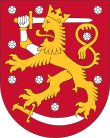 This article is part of the series: Politics and government of Finland |
Other countries · Atlas Politics portal |
The 200-member unicameral Parliament of Finland exercises the supreme legislative authority in Finland. The parliament may alter laws and the constitution, bring about the resignation of the Council of State, and override presidential vetoes. Its acts are not subject to judicial review. Various parliament committees listen to experts and prepare legislation. Proportional vote in multi-seat constituencies is used to elect the parliament for a term of four years. The Speaker of the Parliament of Finland is currently Eero Heinäluoma (Social Democratic Party (Finland)).[45] The cabinet (the Finnish Council of State) exercises most executive powers. It is headed by the Prime Minister of Finland and includes other ministers and the Chancellor of Justice. Parliament majority decides its composition[clarification needed], and a vote of no confidence can be used to modify it. The current prime minister is Jyrki Katainen (National Coalition Party).
Since equal and common suffrage was introduced in 1906, the parliament has been dominated by the Centre Party (former Agrarian Union), National Coalition Partyand Social Democrats, which have approximately equal support and represent 65–80% of voters. After 1944 Communists were a factor to consider for a few decades. The relative strengths of the parties vary only slightly in the elections because of the proportional election from multi-member districts,[clarification needed] but there are some visible long-term trends.[citation needed] In the elections 2011 the True Finns had an exceptional success, rising its representation from 5 to 39 seats and thus surpassing the Centre party. The autonomous Åland islands has separate elections, where Liberals for Ålandwas the largest party in 2007 elections.
After the parliamentary elections on April 17, 2011, the seats were divided among eight parties as follows:
| Party | Seats | Net gain/loss | % of seats | % of votes |
|---|---|---|---|---|
| National Coalition Party | 44 | −6 | 22.0 | 20.4 |
| Social Democratic Party | 42 | -3 | 21.0 | 19.1 |
| True Finns | 39 | +34 | 19.5 | 19.1 |
| Centre Party | 35 | -16 | 17.5 | 15.8 |
| Left Alliance | 14 | -2 | 7.0 | 8.1 |
| Green League | 10 | -5 | 5.0 | 7.3 |
| Swedish People's Party | 9 | 0 | 4.5 | 4.3 |
| Christian Democrats | 6 | -1 | 3.0 | 4.0 |
| Others | 1* | 0 | 0.5 | 0.4 |
| * Province of Åland representative. | ||||
Law
Main article: Judicial system of Finland
The judicial system of Finland is a civil law system divided between courts with regular civil and criminal jurisdiction and administrative courts with jurisdiction over litigation between individuals and the public administration. Finnish law is codified and based on Swedish law and in a wider sense, civil law or Roman law. The court system for civil and criminal jurisdiction consists of local courts (käräjäoikeus, tingsrätt), regional appellate courts (hovioikeus, hovrätt), and the Supreme Court (korkein oikeus, högsta domstolen). The administrative branch of justice consists of administrative courts (hallinto-oikeus, förvaltningsdomstol) and the Supreme Administrative Court (korkein hallinto-oikeus, högsta förvaltningsdomstolen). In addition to the regular courts, there are a few special courts in certain branches of administration. There is also a High Court of Impeachment for criminal charges against certain high-ranking officeholders.
Around 92% of residents are confident in Finland's security institutions.[46] The overall crime rate of Finland is not high in the EU context. Some crime types are above average, notably the highest homicide rate in Western Europe.[47] A day fine system is in effect and also applied to offenses such as speeding.
Finland has successfully fought against government corruption which was more common in the 1970s and 1980s.[48][verification needed] For instance, economic reforms and EU membership introduced stricter requirements for open bidding and many public monopolies were abolished.[48][dubious ] Today, Finland has a very low number of corruption charges; Transparency International ranks Finland as one of the least corrupt countries in Europe. Also, Finland's public records are among the world's most transparent.[verification needed]
According to Transparency International in 2008 the lack of transparency of the Finnish political finance had been amased internationally.[49] According to GRECO in 2007 corruption should be taken into account in the Finnish system of election funds better.[50] Finance scandal of election in 2007 in Finland started in spring 2008. Nine Ministers of Government had lack in their report and even more of the Members of Parliament. The law includes no punishment of false funds reports of the elected politicians.
Foreign relations
Main article: Foreign relations of Finland
According to the latest constitution of 2000, the president (currently Tarja Halonen) leads foreign policy in cooperation with the government, except that the government leads EU affairs.[51]
In 2008, President Martti Ahtisaari was awarded the Nobel Peace Prize.[52] Finland was considered a cooperative model state, and Finland did not oppose proposals for a common EU defence policy.[53] This was reversed in the 2000s, when Tarja Halonen and Erkki Tuomioja made Finland's official policy to resist other EU members' plans for common defense.[53]
Social security
Main article: Social security in Finland
In the late 1980s, Finland had one of the world's most extensive welfare systems, one that guaranteed decent living conditions for all Finns. Since then social security has been cut back, but still the system is one of the most comprehensive in the world.[citation needed] Created almost entirely during the first three decades after World War II, the social security system was an outgrowth of the traditional Nordic belief that the state was not inherently hostile to the well-being of its citizens, but could intervene benevolently on their behalf. According to some social historians, the basis of this belief was a relatively benign history that had allowed the gradual emergence of a free and independent peasantry in the Nordic countries and had curtailed the dominance of the nobility and the subsequent formation of a powerful right wing. Finland's history has been harsher than the histories of the other Nordic countries, but not harsh enough to bar the country from following their path of social development.[54]
Military
Main articles: Finnish Defence Forces and Military history of Finland
See also: List of wars involving Finland
The Finnish Defence Forces consists of a cadre of professional soldiers (mainly officers and technical personnel), currently serving conscripts and a large reserve. The standard readiness strength is 34,700 people in uniform, of which 25% are professional soldiers. A universal male conscription is in place, under which all male Finnish nationals above 18 years of age serve for 6 to 12 months of armed service or 12 months of civilian (non-armed) service.
Alternative non-military service and volunteer service by women (chosen by around 500 annually)[55] are possible. Finland is the only non-NATO EU country bordering Russia. Finland's official policy states that the 350,000 reservists, armed mostly with ground weaponry are a sufficient deterrent.[citation needed]
The Finnish Defense Forces favor partnerships with Western institutions such as NATO, WEU and the EU, but are careful to avoid politics.[56] Finland's defence budget equals about €2 billion or about 1.4–1.6% of the GDP. Finnish defense expenditure is around the sixth highest in the EU.[57] Voluntary overseas service is popular, and troops serve around the world in UN, NATO and EU peace-keeping missions. Residents claim around 80% homeland defense willingness, one of the highest rates in Europe.[58]
The Finnish Defence Forces are under the command of the Chief of Defence (currently General Ari Puheloinen), who is directly subordinate to the President of the Republic in matters related to military command. The branches of the military are the Finnish Army, Finnish Navy and Finnish Air Force. The Border Guard is under the Ministry of the Interior but can be incorporated into the Defence Forces when required for defence readiness.
Economy
Main article: Economy of Finland
See also: List of companies of Finland and Helsinki Stock Exchange
Finland has a highly industrialized mixed economy with a per capita output equal to that of other European economies such as France, Germany, Belgium or the UK. The largest sector of the economy is services at 66%, followed by manufacturing and refining at 31%. Primary production is 2.9%.[59] With respect toforeign trade, the key economic sector is manufacturing. The largest industries[60] are electronics (22%), machinery, vehicles and other engineered metal products (21.1%), forest industry (13%) and chemicals (11%).
Finland has timber and several mineral and freshwater resources. Forestry, paper factories, and the agricultural sector (on which taxpayers spend around 3 billion euros annually) are politically sensitive to rural residents. The Greater Helsinki area generates around a third of GDP. In a 2004 OECD comparison, high-technology manufacturing in Finland ranked second largest after Ireland. Knowledge-intensive services have also ranked the smallest and slow-growth sectors – especially agriculture and low-technology manufacturing – second largest after Ireland.[61] Overall short-term outlook was good, and GDP growth has been above many EU peers.
Finland is highly integrated in the global economy, and international trade is a third of GDP. The European Union makes 60% of the total trade.[citation needed] The largest trade flows are with Germany, Russia, Sweden, United Kingdom, United States, Netherlands and China. Trade policy is managed by the European Union, where Finland has traditionally been among the free trade supporters, except for agriculture. Finland is the only Nordic country to have joined the Eurozone.
Finland's climate and soils make growing crops a particular challenge. The country lies between 60° and 70° north latitude, and has severe winters and relatively short growing seasons that are sometimes interrupted by frosts. However, because the Gulf Stream and the North Atlantic Drift Current moderate the climate, Finland contains half of the world's arable land north of 60° north latitude. Annual precipitation is usually sufficient, but it occurs almost exclusively during the winter months, making summer droughts a constant threat. In response to the climate, farmers have relied on quick-ripening and frost-resistant varieties of crops, and they have cultivated south-facing slopes as well as richer bottomlands to ensure production even in years with summer frosts. Most farmland had originally been either forest or swamp, and the soil had usually required treatment with lime and years of cultivation to neutralize excess acid and to develop fertility. Irrigation was generally not necessary, but drainage systems were often needed to remove excess water. Finland's agriculture was efficient and productive – at least when compared with farming in other European countries.[54]
Forests play a key role in the country's economy, making it one of the world's leading wood producers and providing raw materials at competitive prices for the crucial wood-processing industries. As in agriculture, the government has long played a leading role in forestry, regulating tree cutting, sponsoring technical improvements, and establishing long-term plans to ensure that the country's forests continue to supply the wood-processing industries. To maintain the country's comparative advantage in forest products, Finnish authorities moved to raise lumber output toward the country's ecological limits. In 1984 the government published the Forest 2000 plan, drawn up by the Ministry of Agriculture and Forestry. The plan aimed at increasing forest harvests by about 3 percent per year, while conserving forestland for recreation and other uses.[54]
Private sector employees amount to 1.8 million, out of which around a third with tertiary education. The average cost of a private sector employee per hour was 25.1 euros in 2004.[62] As of 2008 average purchasing power-adjusted income levels are similar to those of Italy, Sweden, Germany and France.[63] In 2006, 62% of the workforce worked for enterprises with less than 250 employees and they accounted for 49% of total business turnover and had the strongest rate of growth.[64] The female employment rate is high. Gender segregation between male-dominated professions and female-dominated professions is higher than in the US.[65] The proportion of part-time workers was one of the lowest in OECD in 1999.[65]
Employment rate 68% and unemployment rate was 6.8% in early 2008.[66] 18% of residents are outside job market at the age of 50 and less than a third working at the age of 61.[67] Unfunded pensions and other promises such as health insurances are a dominant future liability, though Finland is much better prepared than countries such as France or Germany.[68] Directly held public debt has been reduced to around 32% of GDP in 2007.[69] In 2007, the average household savings rate was −3.8 and household debt 101% of annual disposable income, a typical level in Europe.[70] Home ownership rate is 60%.
As of 2006, 2.4 million households reside in Finland. The average size is 2.1 persons; 40% of households consist of a single person, 32% two persons and 28% three or more persons. Residential buildings total 1.2 million and the average residential space is 38 m2 per person. The average residential property without land costs 1,187 euro per sq metre and residential land 8.6 euro per sq metre. 74% of households had a car. There are 2.5 million cars and 0.4 million other vehicles.[71]
Around 92% have a mobile phone and 83.5% (2009) Internet connection at home. The average total household consumption was 20,000 euro, out of which housing consisted of about 5500 euro, transport about 3000 euro, food and beverages excluding alcoholic at around 2500 euro, recreation and culture at around 2000 euro.[72] Purchasing power-adjusted average household consumption is about the same level as it is in Germany, Sweden and Italy.[63]According to Invest in Finland, private consumption grew by 3% in 2006 and consumer trends included durables, high quality products, and spending on well-being.[73]
Education and science
Main article: Education in Finland
See also: List of universities in Finland
Most pre-tertiary education is arranged at municipal level. Even though many or most schools were started as private schools, today only around 3% students are enrolled in private schools (mostly Helsinki-based schools such as SYK), many times less than in Sweden and most other developed countries.[74] Pre-school education is rare compared to other EU countries. Formal education is usually started at the age of 7. The primary school takes normally 6 years, the lower secondary school 3 years, and most schools are managed by municipal officials.
The flexible curriculum is set by the Ministry of Education and the Education Board. Education is compulsory between the ages of 7 and 16. After lower secondary school, graduates may either enter the workforce directly, or apply to trade schools or gymnasiums (upper secondary schools). Trade schools prepare for professions. Academically oriented gymnasiums have higher entrance requirements and specifically prepare for Abitur and tertiary education. Graduation from either formally qualifies for tertiary education.
In tertiary education, two mostly separate and non-interoperating sectors are found: the profession-oriented polytechnics and the research-orienteduniversities. Education is free and living expenses are to a large extent financed by the government through student benefits. There are 20 universities and 30 polytechnics in the country. Helsinki University is ranked 75th in the Top University Ranking of 2010.[75] The World Economic Forum ranks Finland's tertiary education #2 in the world.[76] Around 33% of residents have a tertiary degree, similar to Nordics and more than in most other OECD countries except Canada (44%), United States (38%) and Japan(37%).[77] The proportion of foreign students is 3% of all tertiary enrolments, one of the lowest in OECD, while in advanced programs it is 7.3%, still below OECD average 16.5%.[78]
More than 30% of tertiary graduates are in science-related fields. Forest improvement, materials research, environmental sciences, neural networks, low-temperature physics, brain research, biotechnology, genetic technology and communications showcase fields of study where Finnish researchers have had a significant impact.[79]
Finland had a long tradition of adult education, and by the 1980s nearly one million Finns were receiving some kind of instruction each year. Forty percent of them did so for professional reasons. Adult education appeared in a number of forms, such as secondary evening schools, civic and workers' institutes, study centers, vocational course centers, and folk high schools. Study centers allowed groups to follow study plans of their own making, with educational and financial assistance provided by the state. Folk high schools are a distinctly Nordic institution. Originating in Denmark in the nineteenth century, folk high schools became common throughout the region. Adults of all ages could stay at them for several weeks and take courses in subjects that ranged from handicrafts to economics.[54]
Finland is highly productive in scientific research. In 2005, Finland had the fourth most scientific publications per capita of the OECD countries.[80] In 2007, 1,801 patents were filed in Finland.[81]
Energy
See also: Nordic energy market and Nuclear power in Finland
Anyone can enter the free and largely privately owned financial and physical Nordic energy markets traded in NASDAQ OMX Commodities Europe and Nord Pool Spot exchanges, which have provided competitive prices compared to other EU countries. As of 2007, Finland has roughly the lowest industrial electricity prices in the EU-15 (equal to France).[83]
In 2006, the energy market was around 90 terawatt hours and the peak demand around 15 gigawatts in winter. This means that the energy consumption per capita is around 7.2 tons of oil equivalent per year. Industry and construction consumed 51% of total consumption, a relatively high figure reflecting Finland's industries.[84][85] Finland's hydrocarbon resources are limited to peat and wood.[citation needed] About 10–15% of the electricity is produced by hydropower,[86]which is little compared to more mountainous Sweden or Norway. In 2008, renewable energy forms (mainly hydropower and various forms of wood energy) made high 30.5% compared to the EU average 10.3% in final energy consumption.[87]
Finland has four privately owned nuclear reactors producing 18% of the country's energy,[88] one research reactor in Otaniemi campus, and the fifthAREVA-Siemens-built reactor – the world's largest at 1600 MWe and a focal point of Europe's nuclear industry – is scheduled to be operational by 2013. A varying amount (5–17%) of electricity has been imported from Russia (at around 3 gigawatt power line capacity), Sweden and Norway.
Finland negotiated itself expensive Kyoto and EU emission terms. They might be causing an increase in energy prices, amplified by the aging and soon decommissioned production capacity.[89] Energy companies are about to increase nuclear power production, as in July 2010 the Finnish parliament granted permits for additional two new reactors.



![Location of Finland (dark green)– in Europe (green & dark grey)– in the European Union (green) — [Legend]](http://upload.wikimedia.org/wikipedia/commons/thumb/6/6e/EU-Finland.svg/250px-EU-Finland.svg.png)


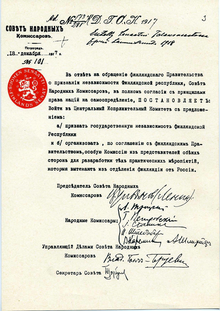
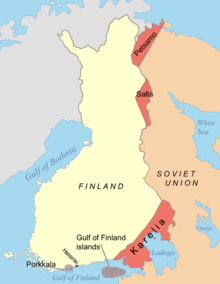


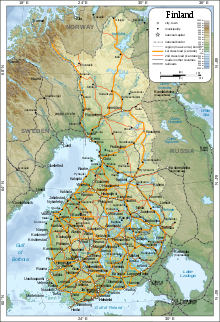

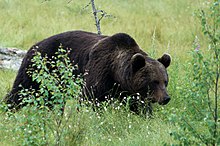
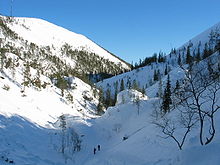


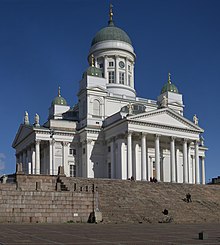





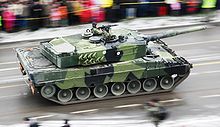

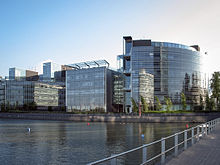
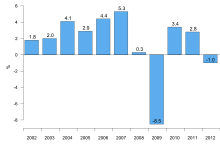
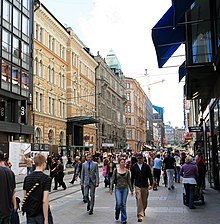
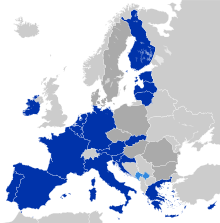

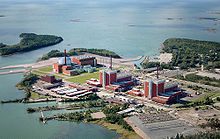
No comments:
Post a Comment